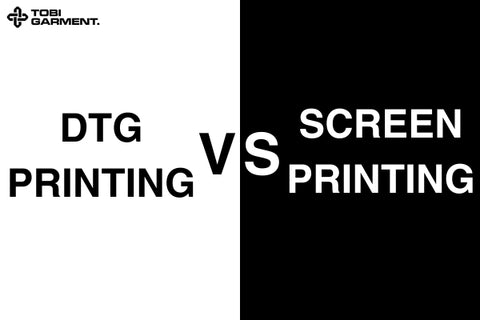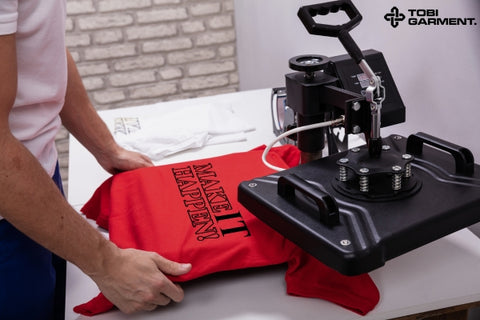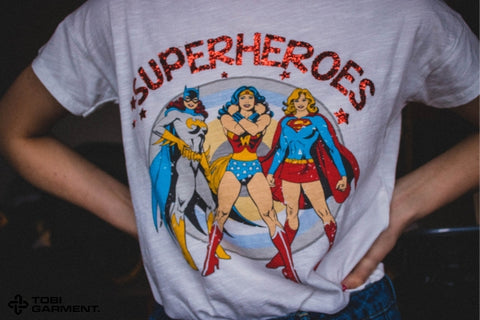
DTG vs Screen Printing. Which method is best for your next project? Don't worry! In this guide, we'll explore the details of DTG (Direct-to-Garment) Printing and Screen Printing, examining their pros, cons, and differences. By the end, you'll have the insights needed to choose the method that best suits your specific needs and goals.
Understanding DTG Printing: A Closer Look
DTG Printing, also known as Direct-to-Garment Printing, is a cutting-edge technology that allows for the direct application of designs onto fabrics, particularly cotton and cotton-blend garments.
This digital printing method utilizes specialized inkjet printers to create full-color, high-quality prints with unparalleled detail and precision.
How DTG Printing Works
The DTG printing process begins with pre-treating the garment with a special solution, ensuring optimal ink absorption and adhesion. Once the fabric is prepared, the design is digitally printed directly onto the surface using water-based inks. These inks penetrate the fabric's fibers, resulting in a soft, comfortable feel and vibrant colors that truly make your designs pop.

Advantages of DTG Printing
DTG Printing offers a multitude of advantages that make it an attractive choice for many custom apparel enthusiasts:
- Detailed and complex designs: With DTG, you can unleash your creativity and bring even the most intricate designs to life, thanks to its ability to handle a full spectrum of colors and fine details.
- Quick turnaround time: The minimal setup required for DTG printing allows for rapid production, making it ideal for small orders or projects with tight deadlines.
- Cost-effective for small quantities: DTG printing proves to be economical for small to medium-sized orders, making it a budget-friendly solution for full-color designs.
- Versatility: DTG printing can be applied to a wide range of fabrics, including cotton, polyester, and blends, allowing you to experiment with different materials and create unique garments.
Read more: Stand Out in Style with All Over Print Football Jerseys
Disadvantages of DTG Printing
While DTG Printing offers numerous advantages, it's essential to consider its limitations:
- Durability: Although DTG printed designs have improved in durability over the years, they may not withstand as many washes as their screen-printed counterparts.
- Fabric limitations: DTG printing works best on light-colored fabrics, as printing on dark garments can be challenging and may result in a less vibrant appearance.
- Cost for larger quantities: While DTG printing is cost-effective for small orders, the cost-per-unit may increase for larger quantities, making it less economical compared to screen printing for bulk production.
Ideal Products for DTG Printing
DTG Printing shines when it comes to creating custom apparel for small businesses, event organizers, and individuals looking to add a personal touch to their garments. Some of the most popular products for DTG printing include:
- T-shirts
- Hoodies
- Sweatshirts
- Polos
- Tote bags
- Pillows
Screen Printing Explained: How Does it Work?
Screen Printing, a traditional printing method that has stood the test of time, involves pushing ink through a woven mesh screen onto the fabric. Unlike DTG printing, the ink sits on top of the garment rather than penetrating the fibers.
The Screen Printing Process
The screen printing process begins with creating a stencil, known as a screen, for each element of the design. Once the screens are ready, the colors and design elements are applied layer by layer onto the garment. The more layers your design has, the longer it will take to print and the thicker the final result will be.

Advantages of Screen Printing
Screen Printing offers several advantages that make it a popular choice among custom apparel enthusiasts:
- Durability: Screen printed designs are known for their longevity, often lasting for decades with proper care and maintenance.
- Vibrant colors: Screen printing allows for the use of thick, opaque inks that result in bold, vibrant colors that truly make your designs stand out.
- Cost-effective for larger quantities: While screen printing may have higher setup costs, it becomes more cost-effective as the quantity of garments increases.
- Versatility: Screen printing can be applied to a wide range of fabrics, including cotton, polyester, and blends, and can even be used on non-traditional surfaces like wood, metal, and glass.
Read more: Start a Shopify T-Shirt Business: Unleash Your Creativity
Disadvantages of Screen Printing
Screen Printing also has its limitations:
- Setup time: The process of creating screens and setting up the printing station can be time-consuming, making it less suitable for small orders.
- Design limitations: Screen printing may not be the best choice for highly detailed or photorealistic designs, as the process works best with simpler, more graphic designs.
- Minimum order quantity: Many screen printing companies have a minimum order quantity, which can be a barrier for those looking to order smaller quantities.
Ideal Products for Screen Printing
Screen Printing is an excellent choice for creating custom apparel in bulk, making it ideal for businesses looking to create branded merchandise, event organizers, and organizations looking to create custom uniforms or team apparel. Some of the most popular products for screen printing include:
- T-shirts
- Hoodies
- Polos
- Hats
- Tote bags
- Promotional items
DTG vs Screen Printing: Which Printing Method is Best for You?
Now that you have a better understanding of both DTG Printing and Screen Printing, it's time to determine which method is the best fit for your specific needs. Consider the following factors when making your decision:
Understanding Your Printing Needs
Before choosing a printing method, it's essential to assess your specific needs, such as:
- The size of your order: If you're looking to print a small quantity of garments, DTG printing may be the more cost-effective option. However, if you're printing in bulk, screen printing may be the better choice.
- The complexity of your design: If your design features intricate details, fine lines, or a wide range of colors, DTG printing may be the better option. For simpler, more graphic designs, screen printing may be the way to go.
- Your budget: DTG printing is generally more cost-effective for small orders, while screen printing becomes more cost-effective as the quantity increases.
Read more: Discover Fun and Creative All Over Print Shirts
Key Differences Between DTG and Screen Printing
While both DTG Printing and Screen Printing are effective methods for creating custom apparel, there are several key differences to consider:
- Cost Comparison:
- DTG Printing: Cost-effective for small orders, but the cost-per-unit may increase for larger quantities.
- Screen Printing: Higher setup costs, but becomes more cost-effective as the quantity increases.
- Quality:
- DTG Printing: Produces high-quality, detailed prints with a wide range of colors and fine details.
- Screen Printing: Produces vibrant, durable prints with bold colors, but may have limitations when it comes to intricate designs.
- Speed and Turnaround Time:
- DTG Printing: Minimal setup time allows for quick turnaround, making it ideal for small orders or projects with tight deadlines.
- Screen Printing: Longer setup time, but becomes more efficient once the initial setup is complete, making it suitable for larger orders.
- Minimum Order Quantity:
- DTG Printing: No minimum order quantity, making it accessible for small businesses and individuals.
- Screen Printing: Many companies have a minimum order quantity, which can be a barrier for those looking to order smaller quantities.
- Design Complexity:
- DTG Printing: Ideal for intricate designs with fine details, gradients, and photorealistic images.
- Screen Printing: Works best with simpler, more graphic designs, but can still accommodate some complexity.
Read more: Start a T-Shirt Business: Your Guide to Creative Success
Frequently Asked Questions
Which printing method is more durable?
Screen Printing: Screen printed designs are known for their longevity, often lasting for decades with proper care and maintenance.
Is DTG printing more cost-effective than screen printing?
- DTG Printing: DTG printing is more cost-effective for small orders, but the cost-per-unit may increase for larger quantities.
- Screen Printing: Screen printing becomes more cost-effective as the quantity increases.
Can DTG printing handle complex designs?
DTG Printing: Yes, DTG printing is ideal for intricate designs with fine details, gradients, and photorealistic images.
What types of fabrics can be used with DTG printing and screen printing?
- DTG Printing: Works best on light-colored fabrics, particularly cotton and cotton-blend garments.
- Screen Printing: Can be applied to a wide range of fabrics, including cotton, polyester, and blends, and can even be used on non-traditional surfaces like wood, metal, and glass.
Read more: Direct-to-Garment vs Sublimation Printing: Pros and Cons
Conclusion
In the end, the choice between DTG Printing and Screen Printing comes down to your specific needs, budget, and design preferences. DTG printing is an excellent choice for small orders, intricate designs, and quick turnaround times, while screen printing shines when it comes to larger orders, vibrant colors, and long-lasting durability.
To summarize the key takeaways:
- DTG printing is ideal for small orders, intricate designs, and quick turnaround times
- Screen printing is cost-effective for larger orders and produces vibrant, durable prints
- Consider factors such as order size, design complexity, and budget when choosing a printing method
- Both DTG printing and screen printing offer unique advantages and are suitable for creating custom apparel
Remember, the best printing method for you will depend on your specific needs and preferences. Don't be afraid to experiment and find the perfect fit for your custom apparel projects!
Read more related posts from Tobi Garment:



